HISTORY OF THE EARLY HISTORY OF JAPAN
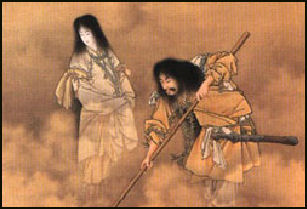
Creation of Japan According to Columbia University’s Asia for Educators: “Although many questions about the origins and early development of the Japanese people remain unanswered, archaeologists have done particularly impressive work since World War II in tracing the existence of human habitation in Japan to a vastly earlier time — perhaps hundreds of thousands of years BCE — than previously thought. [Source: Asia for Educators Columbia University, Primary Sources with DBQs, afe.easia.columbia.edu ]
“Among the sources for our present knowledge of prehistoric Japan are chronicles written by Chinese scholars in the first few centuries CE. The Chinese knew of the islands and their people from a very early date, and although their historians deal with Japan only briefly and as a distant and rather insignificant tributary area, their accounts give many clues to the growth and culture of the early Japanese state.
“The accounts show that during the first five centuries CE the central and southern areas of "Wa," as the Chinese called Japan, were occupied by numerous communities of fairly closely related people who kept some contact with the mainland. Later accounts point to the rise of the kingdom of Yamato in central Honshu, and by at least the fifth century the Yamato ruler was called "King of Wa" by the Chinese. Yamato was securely established, and the stage was set for the true foundation of the historic Japanese state.
The Japanese did not begin to write histories until the seventh century. Inspired by the written histories of China, scholars worked for years assembling information, most of it oral, on the myths, legends, and true stories of the Japanese past. The oldest extant "histories" are the Kojiki (Records of Ancient Matters) of 712 and the Nihon Shoki (or Nihongi, Chronicles of Japan), which was completed in 720.
“Since the authors of Kojiki and Nihon Shoki made no sharp distinction between myth and history, here are set forth the early Japanese beliefs about the creation of the universe and the Japanese islands. Here too we are introduced to the first beings, the gods of the Japanese who are called kami.”
Websites: Yamato Period Wikipedia article on the Yamato period Wikipedia article ; Kojiki, Nihongi and Sacred Shinto Texts sacred-texts.com ; Imperial Household Agency kunaicho.go.jp/eindexList of Emperors of Japan friesian.com ; Buddhism and Prince Shotoku onmarkproductions.com ; Essay on the Japanese Missions to Tang China aboutjapan.japansociety.org . References: 1) The Chronicles of Wa, Gishiwajinden by Wes Injerd; 2) Wa (Japan), Wikipedia; 3) Excerpts from the History of the Kingdom of Wei, Columbia University’s Primary Source Document Asia for Educators. Asuka Wikipedia article on Asuka Wikipedia ; Asuka Park asuka-park.go.jp ; Asuka Historical Museum asukanet.gr.jp ; UNESCO World Heritage sites ; Early Japanese History Websites: Aileen Kawagoe, Heritage of Japan website, heritageofjapan.wordpress.com; Essay on Early Japan aboutjapan.japansociety.org ; Japanese Archeology www.t-net.ne.jp/~keally/index.htm ; Ancient Japan Links on Archeolink archaeolink.com ;Essay on Rice and History aboutjapan.japansociety.org ; Metropolitan Museum of Art Department of Asian Art metmuseum.org; Wikipedia article on the Jomon Wikipedia ; Historical Parks Sannai Maruyama Jomon Site in Northern Honshu sannaimaruyama.pref.aomori.jp ; Yoshinogari Historical Park yoshinogari.jp/en ;Good Photos of Jomon, Yayoi and Kofun Sites at Japan-Photo Archive japan-photo.de ; Wikipedia article on the Ainu Wikipedia ; Good Japanese History Websites: ; Wikipedia article on History of Japan Wikipedia ; Samurai Archives samurai-archives.com ; National Museum of Japanese History rekihaku.ac.jp ; English Translations of Important Historical Documents hi.u-tokyo.ac.jp/iriki
RELATED ARTICLES IN THIS WEBSITE: ANCIENT HISTORY factsanddetails.com; YAYOI PERIOD (400 B.C.– A.D. 300) factsanddetails.com; YAYOI PERIOD AND THE ORIGIN OF MODERN JAPANESE PEOPLE factsanddetails.com; YAYOI PEOPLE, LIFE, AND CULTURE (400 B.C.-A.D. 300) factsanddetails.com; YAYOI METALLURGY factsanddetails.com; YAYOI RELIGION AND BURIALS factsanddetails.com; RICE AGRICULTURE IN THE YAYOI PERIOD factsanddetails.com; FIRST CROPS AND EARLY AGRICULTURE AND DOMESTICATED ANIMALS IN CHINA factsanddetails.com; WORLD'S OLDEST RICE AND EARLY RICE AGRICULTURE IN CHINA factsanddetails.com; WA AND EARLY CONTACTS BETWEEN CHINA AND JAPAN actsanddetails.com; YAMATO AND QUEEN HIMIKO factsanddetails.com; KOFUN PERIOD (A.D. 3RD CENTURY–538) factsanddetails.com; KOFUN PERIOD, CLANS AND EARLY YAMATO RULERS factsanddetails.com; KOFUN RELIGION factsanddetails.com; KOFUN PEOPLE AND LIFE (A.D. 3RD CENTURY–538) factsanddetails.com; KOFUN PERIOD (A.D. 3RD CENTURY–538) KOFUN AND TOMBS factsanddetails.com; KOFUN-ERA JAPAN, CHINA AND KOREA: RELATIONS, INFLUENCES AND TRADE factsanddetails.com
RECOMMENDED BOOKS: “The Kojiki: An Account of Ancient Matters” by no Yasumaro Ō and Gustav Heldt Amazon.com; “Kojiki: The Birth of Japan: The Japanese Creation Myth Illustrated” by Kazumi Wilds Amazon.com; “The Sacred Science of Ancient Japan: Lost Chronicles of the Age of the Gods”; by Avery Morrow (2014) Amazon.com; “Reading the Treatise on the People of the Wa in the Chronicle of the Kingdom of Wei”: The World’s Earliest Written Text on Japan by Arikyo Saeiki and Joshua A. Fogel (2018) Amazon.com; “Japan in Five Ancient Chinese Chronicles: Wo, the Land of Yamatai, and Queen Himiko” by Massimo Soumaré, Mark Hall, et al. Amazon.com; “Himiko and Japan's Elusive Chiefdom of Yamatai: Archaeology, History, and Mythology” by J. Edward Kidder Jr Amazon.com; “The Archaeology of Japan: From the Earliest Rice Farming Villages to the Rise of the State (Cambridge World Archaeology)” by Koji Mizoguchi Amazon.com; “An Illustrated Companion to Japanese Archaeology (Comparative and Global Perspectives on Japanese Archaeology)” by Werner Steinhaus, Simon Kaner, et al. (2020) Amazon.com; “Life In Ancient Japan” by Hazel Richardson Amazon.com; “Daily Life and Demographics in Ancient Japan” (Michigan Monograph Series in Japanese Studies) (2009) by William W Farris Amazon.com; “Archaeology of East Asia: The Rise of Civilisation in China, Korea and Japan” by Gina L. Barnes Amazon.com; “The Role of Contact in the Origins of the Japanese and Korean Languages” by J. Marshall Unger 2008 Amazon.com; “The Cambridge History of Japan, Vol. 1: Ancient Japan” (Volume 1) by Delmer M. Brown Amazon.com
Rice and Mythical Origins of Japan

Kevin Short wrote in the Daily Yomiuri: “The story of Japan as a nation has to start in northern Kyushu. From the coast of Saga and Fukuoka prefectures it’s short hop across the straits to the island of Tsushima, from where you can see the southern tip of the Korean Peninsula. Paddy rice agriculture and iron-making, the two great elements that played pivotal riles in Japan’s early development had to arrive here via this route. [Source: Kevin Short, Daily Yomiuri, February 2010 ]
“Classical mythology also points to Kyushu as a logical starting point for a Japanese civilization based on wet-land farming, Japan’s original creation myth takes place around Awajishima island, at the eastern end of the Seto Inland Sea, and the historic civilization also developed in the Kinki (Osaka) region. The cycle of myths that relate to the development and transmission of agriculture, however, are set in central and southern Kyushu.
“In this myth cycle Amaterasu the Sun Goddess obtains rice seeds from the food goddess, and plants them in sacred paddies which she lays out in her home at Takamabara, “High Plain of Heaven.” Later when all is ready , she dispatches her grandson Ninigi down to earth to found an imperial dynasty, After several generations and various adventures in Kyushu the heirs to the imperial line set out n a great journey eastward, sailing through the Seto Inland Sea and ending up in what is now Nara (near Osaka).
“Early Chinese historical sources, unfortunately, provide little insight as to where the Japanese state developed. The first source to offer detailed information on Japan, an historical document called the Wajinden, or “Account of the Wa”, was compile in th year 280, and was based n diplomatic missions sent by the Chinese government several decades earlier. The envoys reported visiting a kingdom known as Yamatikoku, ruled by a shamanese queen named Himiko. The account notes that the people of this kingdom were wet rice farmers using iron and silk, but not keeping domestic cattle or sheep, Himiko lived in a substantial palace, and assumed the throne after a long period of civil war.
“The problem with the Chinese account is that there is no firm information on where Yamatikoku was located. “Based on various interpretations no less than 10 sites, including one in northern Honshu, have been proposed as location sites. Most scholars narrow the candidates down to two contenders: Kyushu and the southern Nara basin. Proponents of the Kyushu theory lace Himiko’s palace in eastern saga Prefecture at the expansive archeological site of Yoshinogari. Unfortunately for the Kyushu supporters, the discovery in 2009 of even more extensive remains at the Makimuku site in Nara has made that area the current favorite.”
Japanese Emperor

Imperial regalia of the Japanese Emperor
The Yamato leaders claimed descent from the sun goddess, Amaterasu. The title of emperor (“tenno”) was introduced around the 5th century.
The Japanese Emperor is a member of the world’s longest ruling dynasty. Although there is no historical documentation that proves the dynasty began 2,600 years ago with Emperor Jimmu, as is claimed, there is proof that it has been around since the A.D. 7th century.
The British monarchy dates back to around the A.D. 6th century and the Chinese imperial throne goes back to around 1500 B.C. but each of them were comprised of different dynasties made up of different families, sometimes from different places. Members of the Japanese monarchy, by contrast, have belonged to a single family.
Historians believe the emperor system probably goes back even further than the 7th century. The first emperor was the legendary Jimmu Tenno. It is not known whether Jimmu actually existed, was a composite of several figures or was a complete fabrication. The dates attributed to Jimmu’s reign, 660 B.C. to 585 B.C., are impossibly early and arrived at arbitrarily in the 8th century historical record, the “Nihon Shoki”. If Jimmu existed he probably lived between 40 B.C. and 10 B.C. The present emperor, Emperor Akihito, is considered the 125th descendant in line from Emperor Zinmu.
Rise of the Solar Uji and the Nakatomi/Fujiwara
According to “Topics in Japanese Cultural History”: As its name implies, this uji claimed descent from the sun (or its equivalent, the solar deity Amaterasu). Archaeological evidence strongly suggests that this uji changed its alleged ancestor several times in the distant past, but by the sixth century, if not earlier, it was claiming descent from the sun, a claim that continued into modern times. Did the other powerful uji allied with it believe this claim of solar descent? It is hard to say with certainty, but they did seem to recognize the superiority of the solar uji, at least in theory. In practice, however, there were numerous occasions when theoretically subordinate allied uji threatened to usurp the solar uji’s superior position. An uji with the name Soga, for example, came very close to eliminating and replacing the solar uji during the early 600s. With assistance of members of other, non-Soga uji who also felt threatened by the powerful Soga, leading members of the solar uji launched a violent attack on the Soga in 645, killing its leaders. [Source: “Topics in Japanese Cultural History” by Gregory Smits, Penn State University figal-sensei.org ~]
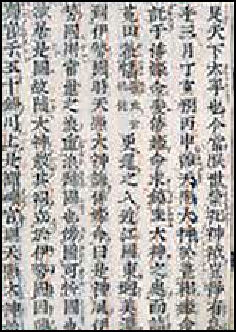
Nihon shoki “To consolidate its victory, the solar uji declared its head "emperor" of the Japanese islands. So it is only from this time that most of the Japanese islands came under the control of a centrally-located monarch--at least in name. So now let us change its name from solar uji to imperial clan or imperial family. In fact, however, the newly-named imperial clan lacked the military power to enforce its claims of emperorship at this time. As before, it had to rely on the backing of its allies. The major difference was that instead of the Soga uji, it was an uji called Nakatomi that now wielded the predominance of power in the confederation. In 669, the head of the imperial clan granted the Nakatomi a new name in honor of their service. Henceforth, this powerful uji was called Fujiwara. As we will see, although requiring two centuries to accomplish, the Fujiwara eventually usurped most of the power of the imperial clan. But they learned from the Soga’s fate and never sought to call themselves emperors or to take over the emperor’s position directly. Instead, they ruled from behind the scenes and preferred marriage politics to the politics of military force--but we are getting ahead of ourselves. ~
“Returning to the late seventh century, even with Fujiwara support, the new imperial clan lacked the military power necessary for it to rule in both name and in fact as a central monarch. This situation changed in 673 when Tenmu (r. 673-686) came to the throne as emperor. Though a member of the imperial family, Tenmu was not the legitimate heir to the throne. He took over the throne by force, which may have been a good thing for the imperial family in hindsight. The reason?--Tenmu possessed significant military force in the form of soldiers loyal to him. With this force, he was able to make himself emperor both in name and in fact. Tenmu sought to bolster his own legitimacy on the throne and the legitimacy of the imperial family as emperors of the Japanese islands. He and his immediate successors went about this task along three main routes. First, they sought to re-organize the institutions of central government, a process that was not complete until the first decade of the eight century. Second, they sought to enhance their symbolic authority by re-organizing titles of nobility, rites and rituals, and, especially, by embracing and using Buddhism--a topic we explore later. Finally, Tenmu initiated the writing of two official histories, which were not completed until well into the with century. These official histories, Record of Ancient Matters (Kojiki, 712 ) and Chronicles of Japan (Nihongi, 720, also known as Nihonshoki). Not surprisingly, these official histories present narratives that legitimize the imperial family as the rightful, natural, heavenly-ordained rulers of the Japanese islands. The other powerful uji are also presented as having a rightful place in the order of things, albeit below that of the imperial family.” ~
Japanese Creation Myth: the Beginning

Early Japanese history, myth and religion are intertwined. According to Columbia University’s Asia for Educators: “Out of a mass of vague and contradictory details emerged a mythical picture of the creation of Japan and its people. For generations the story was transmitted orally and finally written down.” Versions of Japanese creation myth which lie at the foundations of the Japanese religion Shintoism and Japanese Imperial rule are found in the the ancient chronicles “Kojiki” (A.D. 712) and “Nihon Shoki” (A.D. 720).
According to the Japanese creation myth described in the “Kojiki” and “Nihon Shoki” creation began with negative and positive forces coming together and forming an egg-shaped mass with light elements rising to create the heavens and heavy elements falling to form the Earth. “Now when Chaos had begun to condense, but force and form were not yet manifest, and there was naught named, naught done, who could know its shape? Nevertheless, Heaven and Earth first parted and the Three Deities performed the commencement of Creation; the Passive-Active Essences then developed and the Two Spirits became the ancestors of all things.” [Source: “Kojiki” (Records of Ancient Matters), translated by B. H. Chamberlain (Kobe: J. L. Thompson and Company Ltd. 1932, Asia Society of Japan)+++]
The islands of Japan were created by the god Izangi-no-Mikoto (“Male Who Invites”) and his younger sister the goddess Mikoto-no-Izanami (“Female Who Invites”) and separated from the rest of the world when the Heavenly Jeweled Spear was thrust into the ocean from the Floating Bridge of Heaven. Sea water dripping from the spear coalesced into the island Onogoro-jima where the god and goddess lay together producing the islands of Japan along with eight million natural deities (“kami”), including ones for mountains, rivers, trees, crops and other natural things.
According to the Creation Myths in the “Kojiki” and the “Nihon Shoki”: “To make, consolidate, and give birth to this drifting land. So the two deities standing upon the Floating Bridge of Heaven pushed down the jeweled spear and stirred with it; whereupon when they had stirred the brine until it [curdled] and drew the spear up, the brine that dripped down from the end of the spear piled up and became an island. Fourteen islands the pair created — eight great islands and six lesser ones. The island with one body and four faces was called the Lovely-Princess. Others were called by such names as Prince-Good-Boiled-Rice, brave-Good-Youth, Luxuriant-Sun-Youth. Last born was Great-Yamato, the Luxuriant-Island-of-the Dragonfly. [Source: +++“Kodo: The Way of the Emperor” by Mary A. Nourse, pp. 14-18, by The Bobbs-Merrill Company Inc. The text is copied as it appears in “Japan: Selected Readings by Hyman Kublin,” pp. 25,34-38, 1968 by Houghton Mifflin Company ]
For centuries, Japanese children learned the Japanese creation myth as if it were historical fact. The Yamato clan, probably arrived from Korea or China, or possibly Pacific islands to the south. Some scholars see some Chinese influences in the myth such as the yin-and-yang like quality of the positive and negative state of the universe in the beginning of time. Some have argued the whole thing was way too abstract for it be truly Japanese in origin. Aspects of the myth that have been described as distinctly Japanese include the way things sprung up through spontaneous creation and sexual generation and the emphasis on purity and the distaste for things that are polluted or dirty.
Creation of Amaterasu (the Sun Goddess) and Quarreling Gods

Amaterasu by Hoen
Izanami gave birth to 35 gods but was badly burned and died after giving birth to the fire god. Izanagi followed her into the land of the dead to retire but changed his mind after seeing Izanami disfigured with “putrefying matter” and “maggot swarms” and ran away. He was pursued by 80 Ugly Females and escaped by placing a boulder between the lands of the living and the dead. After returning to the world of the living he purified himself in a stream and gave birth to more deities, including the Sun Goddess Amaterasu Omikami, moon good Tsukuyomi-no-Mikito and the ocean god Susano-o-no-Mikito, who were created by washing his right eye, left eye and nose.
Amaterasu Omikami is most important Japanese deity. The rising sun on the Japanese flag symbolizes the special relationship between the sun (Amaterasu) and Japan. Because the rest of the world is reliant on the sun, Japan theoretically has power over it. Amaterasu Omikami is the supreme being of Ise Temple, Japan’s most important religious facility. She is credited with creating the Three Treasures (mirror, sword and jewel)’symbols of the Emperor’s power and authority. Some historians theorize that belief in the Sun Goddess was introduced by sun worshipers from Korea or China. Among sun worshipers, throughout history and around the globe, high positions were often held by priestesses. Some historians have speculated that the first Japanese Emperor, Jimmu Tenno, was the offspring of one of such priestess and an invading chieftain.
According to the Creation Myths in the “Kojiki” and the “Nihon Shoki”: “Having given birth to the islands of Japan, the creative pair produced numerous gods and goddesses... The last of these was known as the Deity of Fire. After his birth Izanami retired to Hades, leaving the process of creation to be carried on by Izanagi alone. From his sword, [belt], and other articles of clothing were born various deities. The three most illustrious among them were... the Sun Goddess, the Moon Goddess, and the God of Force, or Impetuous Male... Little more is written of the moon Goddess, but the Sun Goddess and her brother, Impetuous Male, carried on the task of creation by biting off and crunching parts of the jewels and swords which they wore and blowing them away. From the fragments were formed numerous gods and goddesses who became the heads of various clans. Thus was man created to inhabit the islands. [Source: “Kodo: The Way of the Emperor” by Mary A. Nourse, pp. 14-18, by The Bobbs-Merrill Company Inc. The text is copied as it appears in “Japan: Selected Readings by Hyman Kublin,” pp. 25,34-38, 1968 by Houghton Mifflin Company; Asia for Educators Columbia University, Primary Sources with DBQs, afe.easia.columbia.edu ]
Battle Between Amaterasu (the Sun Goddess) and Her Brother
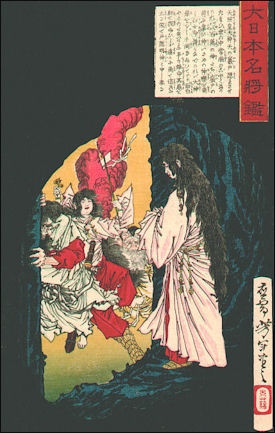
Amaterasu appearing from the cave
Amaterasu Omikami ("Great Heaven-Illuminating Diety") ruled the High Plain of Heaven but descended to a cave plunging he world into darkness, after quarreling with Susano, who played a number of dirty tricks on her including placing some excrement on her throne in her new palace. She remained in the cave until she was lured out by the obscene dancing of the “kagura” dancer and the god Ame-ono-Uzume and light was restored. Later Japan was given to Susano-o’s son Okuninushi who passed it on to Ninigi, Amaterasu Omikami’s grandchild.
According to the Creation Myths in the “Kojiki” and the “Nihon Shoki”: The Sun Goddess and her brother quarreled violently. The climax of the quarrel came when Impetuous Male broke a hole in the roof of heaven, over the place where his sister and her celestial weaving maidens were sitting at work. Through the hole he let fall a piebald (black and white) horse. The Sun Goddess, infuriated, retired into a cave, and darkness prevailed over all the universe. "The Plain-of-High-Heaven was obscured, and all the Central-Land-of-Reed-Plains darkened." [Source: “Kodo: The Way of the Emperor” by Mary A. Nourse, pp. 14-18, by The Bobbs-Merrill Company Inc. The text is copied as it appears in “Japan: Selected Readings by Hyman Kublin,” pp. 25,34-38, 1968 by Houghton Mifflin Company; Asia for Educators Columbia University, Primary Sources with DBQs, afe.easia.columbia.edu ]
“The eight hundred deities, terrified at the darkness, undertook to placate the Sun Goddess. For this purpose they met in assembly. They ordered iron to be taken from the Heavenly-Metal Mountains. Then they called in the smith, charged the Again Forging-Old-Woman to make a mirror, and commanded His-Augustness-Grand-Jewel-Ancestor to produce a string eight feet long of five hundred curved jewels. They hung the newly wrought mirror and the jewels, together with white... and blue... offerings, upon the branches of a tree.
“His-Augustness-Grand-Jewel Ancestor recited [rituals] concerning Her Highness, the Sun Goddess and danced wildly. Amused at his antics, the eight hundred deities shook the Plain-of-High-Heaven with laughter. The Sun Goddess was thus surprised out of her seclusion, and came forth asking how it was that, with all heaven and earth darkened, the deities could indulge in laughter. They answered that they rejoiced because there was a deity more beautiful than Her Augustness; but, while they were speaking, the mirror was brought forward for her to see this most beautiful one. When she looked, she was so surprised at the beauty of the goddess mirrored there that she came forth from the cave. ... The-Plain-of-High-Heaven and the Central-Land-of-Reed-Plains (Japan) were again light. Thus were light and darkness created.”
Creation of the Japanese People and the Emperor
The creation of the Japanese people began when Ninigi descended to the lower realms of the heavens. He took with him what became the three imperial regalia — a curved jewel (magatama), a mirror, and a "sword of gathered clouds" — and ruled over the island of Kyushu. His great grandson Jimmu Tenno was the first emperor of Japan. Members of the House of Yamato — the Imperial family of Japan, which unified the islands of Japan and are still around today — are purportedly Jimmu’s decedents. The belief that the Emperor was the Son of Heaven and the impact of this belief on Japanese political life can be traced back to the Taika reforms in A.D. 645.
According to the Creation Myths in the “Kojiki” and the “Nihon Shoki”: “For his misdeeds, Impetuous Male was banished from heaven. He wandered on the earth and begged food of the Deity-Princess-of-Great-Food, who took all sorts of things from her nose, her mouth, and other parts of her body, and turned them into food for him. Thinking she was offering him filth, however, he killed her. After her death the Deity-Producing-Wondrous-Ancestor commanded that these useful things born from her body be used propagate food and clothing — silkworms from her head, rice seeds from her eyes, millet from her ears, beans from her nose, barley from her torso. [Source: “Kodo: The Way of the Emperor” by Mary A. Nourse, pp. 14-18, by The Bobbs-Merrill Company Inc. The text is copied as it appears in “Japan: Selected Readings by Hyman Kublin,” pp. 25,34-38, 1968 by Houghton Mifflin Company; Asia for Educators Columbia University, Primary Sources with DBQs, afe.easia.columbia.edu ]
“Besides looking for food, the Impetuous-Male-Deity performed many wondrous deeds while wandering about on earth... At one time he came upon an old man and an old woman who were crying. Inquiring the cause of their sorrow, he found that the eight-forked serpent of Hoshi had been visiting them each year, and on each visit had devoured one of their eight daughters, until now only one was left, and they were full of apprehension about the fate of their last daughter.
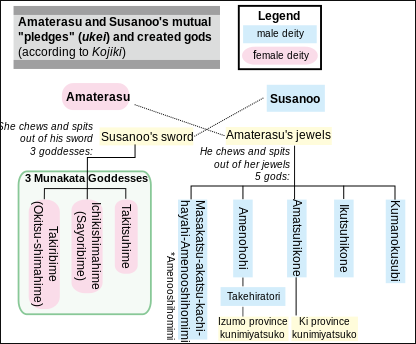
Challenge of Amaterasu and Susanoo
“When Impetuous Male heard the story, he asked for the hand of this last daughter in marriage. Having been granted his request, he turned the girl into a comb which he stuck in his hair. He then lay in wait for the coming of the eight-forked serpent whom he overpowered and cut in pieces; but when he cut into the middle tail, the edge of his sword broke. When he looked to see the cause of this accident, he found concealed in the serpent a sharp great sword, over which he marveled, and then presented it to the gods of heaven. This became known as the Herb-Quelling-Great-Sword, which still serves as one of the emblems in the regalia of Japanese emperors. Thus do the myths account for the symbols of the imperial [power] — the mirror, the jewels, and the sword.
“Finally, Impetuous Male sought a permanent [home] upon the earth. It is said that he "sought in the land of Izumo for a place where he might build a palace. Then he arrived at a place [called] Suga, and said: 'On coming to this palace, my august heart is pure,' and in that place he built a palace to dwell in. So that place is now called Suga." His descendants continued to live in Izumo until the descendant of the sixth generation was vested with the sovereignty of Japan.
“This position he was not allowed to hold, however, for the Sun Goddess, who had never forgiven her brother for his pranks and [misbehavior], felt that none of his children should rule the Central-Land-of-Reed-Plains, in spite of the fact that they had so long been wandering in them. She therefore decided to send a grandson of her own who should rule the earth. For this task she chose a prince..., giving him as parting gifts the eight feet of curved jewels and the mirror which had lured her from the cave, and, also, the Herb-Quelling-Great-Sword which her brother had presented to the gods of heaven.
“After receiving [these, the] prince... left the heavenly rock seat... and descended to the peak of a mountain... on the island of Kyushu. Then began the struggles between the grandson of the Sun Goddess and the descendants of Impetuous Male. The conflict ended when the god... retaining spiritual power only gave up his temporal power to the Sun Goddess' grandson. From the latter descended a prince who is known as the first emperor of Japan — Jimmu — whose reign the Japanese have fixed as beginning in 660 BCE. Thus was created a divine sovereign who is still worshipped as the first in a "lineal succession unbroken for ages eternal."
Jimmu
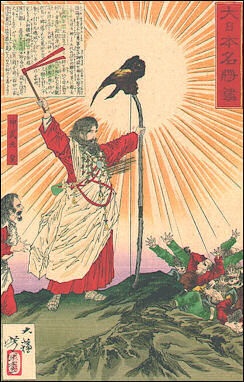
Jimmu
Jimmu Tenno, the first legendary emperor of Japan, is said to be the great grandson of Ninigi, the god who descended to the lower realms of the heavens, bringing with him what became the three imperial regalia — the curved jewel (magatama), a mirror, and a "sword of gathered clouds". Ninigi was the the grandson of Amaterasu (the Sun Goddess).
Jimmu initially ruled over the island of Kyushu and made his mission to conquer Yamato. On the main island of Honshu, according to tradition he established the unbroken line of imperial descent from the Sun Goddess and founded the Land of the Rising Sun in 660 B.C. Members of the House of Yamato, the imperial family that unified the islands of Japan and are still around today, are purportedly Jimmu's decedents. [Source: Library of Congress]
Jimmu is the great-great-grandson of Amaterasu Omikami. Some historians theorize that belief in the Sun Goddess was introduced by sun worshipers from Korea or China. Among sun worshipers, throughout history and around the globe, high positions were often held by priestesses. Some historians have speculated that the first Japanese Emperor, Jimmu Tenno, was the offspring of one of such priestess and an invading chieftain.
It is not known whether Jimmu actually existed, was a composite of several figures or was a complete fabrication. The dates attributed to Jimmu's reign, 660 B.C. to 585 B.C., are impossibly early and arrived at arbitrarily in the 8th century historical record, the Nihon Shoki. If Jimmu existed he probably lived between 40 B.C. and 10 B.C. The present emperor, Emperor Akihito, is considered the 125th descendant in line from Emperor Jimmu
In Japan, February 11th is Commemoration of the Founding of Japan Day. It marks the ascension of the legendary emperor Jimmu to the throne in the 7th century B.C. It was an important day in State Shintoism before World War II and was a day when military parades were held. Now is an important day for ultra-nationalists.
Three-Legged Crow and the Japanese Creation Myth
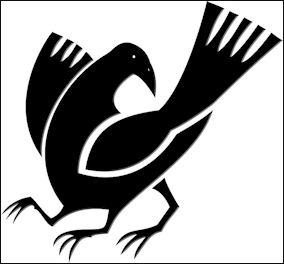
The black crow is a symbol of Japan that appears on uniforms of Japan's national soccer team. The crow has such a high status because it is directly connected to one of the most pivotal episodes in Japan's classic mythology. A close look at the emblem on the soccer uniforms reveals that the crows has three, not two, legs. [Source: Kevin Short, Daily Yomiuri, June 17, 2010 ^^]
Kevin Short, a cultural anthropology professor in Tokyo, wrote in the Daily Yomiuri, “When Japan's first Emperor the legendary Jimmu tried to establish a new capital in Nara the route to the Nara Basin was through a long stretch of steep, densely forested mountains. Once in the forest Jimmu's expedition quickly lost their way. At this point Amaterasu the Sun Goddess stepped in and dispatched her own familiar spirit, a giant three-legged solar crow called the Yata-garasu, which guided the expedition along the difficult mountain path all the way to Yoshino at the southern edge of the Nara Basin." ^^
“The concept of a giant crow associated with the sun is thought to have originated in China, and may have first developed as an explanation for sunspots. Also, crows were long believed to serve the local kami deities in the Kii region. Images of a three-legged crow inside a sun circle have been found on the wall of an ancient barrow grave on the Korean Peninsula, and even today can be seen on the banner of the Kumano-Hongu shrine, the center of the Kii Peninsula's sacred lands and pilgrimage paths." ^^
“The Yata-garasu on the national soccer team emblem is said to symbolize power and quickness. The symbol was adopted in 1931, in honor of Kakunosuke Nakamura (1878-1906), considered to be the founding father of soccer here in Japan.” ^^
How Jimmu Arrived in Yamato (Nara)
Ihare, the Divine Grandchild of Amaterasu, set out on a grand Expedition to the East. He used great sword Futsu-no-Mitama to cut down evil spirits that tried to block his way and was guided by Yata-garasu, the giant three-legged solar crow. The expedition passed though great forests and climbed lofty peaks, before finally arriving in the Japanese promised land of Yamato — a broad, flat basin that is surrounded on all sides by mountains — and was selected as the site for a divine kingdom. Ihare built a grand palace and ruled as Jimmu for the next 76 years. Yamato is the southern Nara basin, near present-day Osaka and Kyoto.
Describing the establishment of the Japanese capital in Nara, Kevin Short, a cultural anthropology professor in Tokyo, wrote in the Daily Yomiuri, “When Amaterasu the Sun Goddess wished to establish a kingdom here on earth, she equipped her grandson with rice seeds and various imperial paraphernalia and sent him down to the island of Kyushu. A few generations later, however, the heir to the throne, Iwarehiko (Jimmu), decided that the land could be better governed from a more central location, and set out on a journey to the east." [Source: Kevin Short, Daily Yomiuri, June 17, 2010 ^^]
“After sailing through the Seto Inland Sea, the imperial expedition landed on the shores of what is now Osaka. From here they planned to push eastward over the Ikoma and Kongo mountains into the fertile Nara Basin. Before they could even gain a foothold, however, they were turned away by fierce resistance from the local clans. Back in their boats they sailed south then eastward, rounding the Kii Peninsula and landing somewhere near modern day Nachi-Katsuura in Wakayama Prefecture. From here the route to the Nara Basin lay to the north, passing over a long stretch of steep, densely forested mountains. Once in the forest the expedition quickly lost their way. Furthermore, enthralled in a powerful spell woven by a local bear sorcerer, all the men fell into a deep stupor." ^^
“But Amaterasu the Sun Goddess was not ready to abandon her descendent and protege. From the High Plain of Heaven she had a magical seven-pronged sword sent down and presented to Ihare. With sword in hand, the sorcerer's spell immediately dissolved. Next, Amaterasu dispatched her own familiar spirit, a giant three-legged solar crow called the Yata-garasu, which guided the expedition along the difficult mountain path all the way to Yoshino at the southern edge of the Nara Basin." ^^
“Arriving in Nara, Iwarehiko subdued all the rebellious clans and established the kingdom of Yamato. In history books he is better known as Jimmu, the first in Japan's long line of imperial emperors that still continues today."
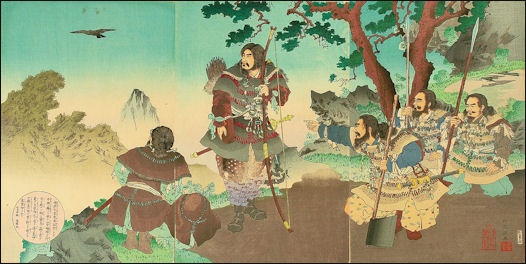
Jimmu's journey to Nara
Early Legendary Rulers of Japan
Jimmu (660-585 B.C. in the Nihon Shoki, mythological).
Suizei (581-549 B.C. in the Nihon Shoki, largely fiction).
Annei (549-511 B.C. in the Nihon Shoki, largely fiction).
Itoku (510-477 B.C. in the Nihon Shoki, largely fiction).
Kosho (475-393 B.C. in the Nihon Shoki, largely fiction).
Koan (392-291 B.C. in the Nihon Shoki, largely fiction).
Korei (290-215 B.C. in the Nihon Shoki, largely fiction).
Kogen (214-158 B.C. in the Nihon Shoki, largely fiction).
Kaika (158-98 B.C. in the Nihon Shoki, largely fiction).
Sujin (97-30 B.C.in the Nihon Shoki, largely fiction). Suinin (29 B.C.-A.D.70 in the Nihon Shoki, largely fiction).
Keiko (71-130 in the Nihon Shoki,might be real, possibly in the 4th century).
Seimu (A.D. 131-190 in the Nihon Shoki, might be real, possibly in the 4th century).
Chuai (A.D. 192-200 in the Nihon Shoki, might be real, possibly in the 4th century).
Jingu Regent for Empress Himeko (A.D. 201-269 in the Nihon Shoki, might be real, mid 3rd century, female ruler). [Source: Charles T. Keally, Professor of Archaeology and Anthropology (retired), Sophia University, Tokyo, t-net.ne.jp/~keally/kofun , The Nihon Shoki is an ancient history record finished in A.D. 720]
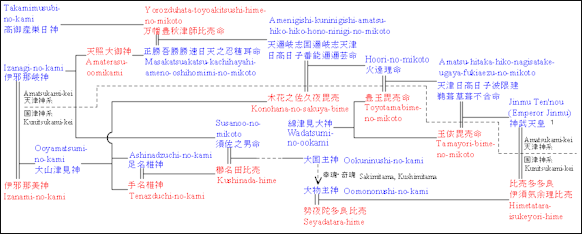
Emperor's family tree
Three Imperial Regalia
Charles T. Keally wrote: “ The Japanese Imperial Family is identified with three sacred objects -- the mirror, sword and curved jewel, or magatama -- the Three Imperial Regalia. When exactly these three objects became a set of symbols of the Imperial Line is not clear. But they were already important religious symbols by the Middle Yayoi Period, and are abundant in the tombs of the Kofun Period. [Source: Charles T. Keally, Professor of Archaeology and Anthropology (retired), Sophia University, Tokyo, t-net.ne.jp/~keally/kofun ++]
“The roots of the mirror are unknown. Han Chinese mirrors were common in northwestern Kyushu by Middle Yayoi, and these were preceded by a few mirrors brought from Korea a bit earlier. The third-century Wei mirrors of Late Yayoi were common in both northwestern Kyushu and in Kinai. Mirrors were a major burial object in Kofun Period tombs, especially the earlier ones, but they are not always -- or even mostly -- associated with the other three symbols. ++
The mirror from the beginning was perhaps a representation of the Sun Goddess, the ancestor of the Imperial Line. But it might also have been a talisman to ward off evil. It is not known whether the ideas surrounding the mirror were imported from the continent together with the mirror, or whether the Yayoi people simply saw the mirror as a useful symbol of ideas they already had. ++
“The sword (or weapon) might be a symbol of male virility and have its roots in the Jomon stone phallic symbols, thought to represent male fertility. By Latest Jomon, however, these stone phallic symbols looked more like stone swords than phalluses. Bronze swords and spears were originally imported from Korea beginning about the end of Early Yayoi. Later, obviously ritual forms of these weapons were manufactured in Japan and are common in Yayoi sites -- spears in northwestern Kyushu and swords in western Honshu and Shikoku. Swords are common in Kofun Period burials, especially the later ones. ++
“The magatama’s origins are more controversial. These curved jewels of jadeite are common in Kofun Period burials, and they are common also in Korean sites of the same age. This fact seems to have led most archaeologists to conclude that the magatama originated in Korea. But magatama are found in Yayoi sites, too, and unquestionable true magatama are reported also in Jomon sites in Tohoku as early as about 1000 B.C., long before true magatama appeared in Korea. The magatama apparently represents the soul. Tama in Japanese means jewel (ball, bullet) and is also part of tamashi, the Japanese word for soul or spirit. I am no linguist, so I can only guess that this similarity is not a coincidence but rather a relationship that has ancient roots.” ++
Image Sources: Wikimedia Commons
Text Sources: Aileen Kawagoe, Heritage of Japan website, heritageofjapan.wordpress.com; Charles T. Keally, Professor of Archaeology and Anthropology (retired), Sophia University, Tokyo ++; Topics in Japanese Cultural History” by Gregory Smits, Penn State University figal-sensei.org ~; Asia for Educators Columbia University, Primary Sources with DBQs, afe.easia.columbia.edu ; Ministry of Foreign Affairs, Japan; Library of Congress; Japan National Tourist Organization (JNTO); New York Times; Washington Post; Los Angeles Times; Daily Yomiuri; Japan News; Times of London; National Geographic; The New Yorker; Time, Newsweek, Reuters; Associated Press; Lonely Planet Guides; Compton’s Encyclopedia and various books and other publications. Many sources are cited at the end of the facts for which they are used.
Last updated September 2016
